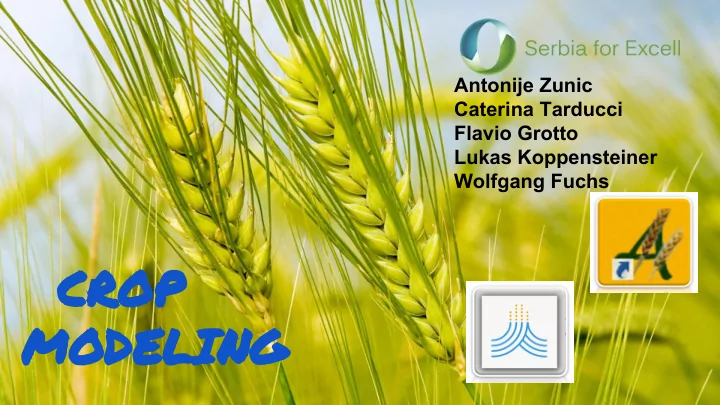

Antonije Zunic Caterina Tarducci Flavio Grotto Lukas Koppensteiner Wolfgang Fuchs CROP MODELING
Problem solving Challenge The challenge is how to design deficit irrigation schedule for crop production under extreme water scarcity.
CASE STUDY As case study, we tried to design a deficit irrigation schedule for tomato in Tunis by considering to have an availability of only 300 mm of water for irrigation. In this situation, a certain level of plant water stress is unavoidable. In this respect, deficit irrigation has the aim to minimize the expected stress. So it is necessary to identify the less sensitive phases in the crop development during which it is possible to stress the plant without damages, while applying the available water during the critical phases.
Crop Models APSIM AquaCrop
Tunis Weather Data - Rainfall Per month (1979-2002 avg.) Yearly variation
→ AquaCrop
Irrigation Schedules ● Without irrigation (0 mm) ● Good/high irrigation → potential production ● Optimized deficit irrigation (300 mm limit)
Without irrigation
High irrigation Days after Stage Threshold Irrigation [mm] planting 1-60 Vegetative growth Stomata closure 30 60-130 Flowering Above stomata 30 closure 130+ End of ripening - 0
High irrigation
Optimized Deficit irrigation Days after Stage Threshold Irrigation [mm] planting 1-65 Vegetative growth Far below canopy 30 senescence 65-110 Flowering Below canopy 30 senescence 110+ End of ripening - 0
Optimized Deficit irrigation
Results Optimized deficit irrigation compared to good irrigation: ● -30% yield ● -50% irrigation water
CONCLUSIONs The AQUACROP model is a useful tool to design deficit irrigation schedules to optimize irrigation water use , yield and water productivity levels under different scenarios.
Thank you for your attention!
Recommend
More recommend